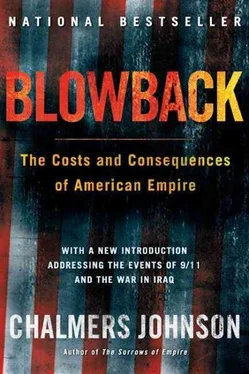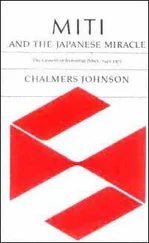Chalmers Johnson - Blowback, Second Edition - The Costs and Consequences of American Empire
Здесь есть возможность читать онлайн «Chalmers Johnson - Blowback, Second Edition - The Costs and Consequences of American Empire» весь текст электронной книги совершенно бесплатно (целиком полную версию без сокращений). В некоторых случаях можно слушать аудио, скачать через торрент в формате fb2 и присутствует краткое содержание. Год выпуска: 0101, ISBN: 0101, Издательство: Macmillan, Жанр: Старинная литература, на английском языке. Описание произведения, (предисловие) а так же отзывы посетителей доступны на портале библиотеки ЛибКат.
- Название:Blowback, Second Edition: The Costs and Consequences of American Empire
- Автор:
- Издательство:Macmillan
- Жанр:
- Год:0101
- ISBN:9780805075595
- Рейтинг книги:5 / 5. Голосов: 1
-
Избранное:Добавить в избранное
- Отзывы:
-
Ваша оценка:
- 100
- 1
- 2
- 3
- 4
- 5
Blowback, Second Edition: The Costs and Consequences of American Empire: краткое содержание, описание и аннотация
Предлагаем к чтению аннотацию, описание, краткое содержание или предисловие (зависит от того, что написал сам автор книги «Blowback, Second Edition: The Costs and Consequences of American Empire»). Если вы не нашли необходимую информацию о книге — напишите в комментариях, мы постараемся отыскать её.
Blowback, Second Edition: The Costs and Consequences of American Empire — читать онлайн бесплатно полную книгу (весь текст) целиком
Ниже представлен текст книги, разбитый по страницам. Система сохранения места последней прочитанной страницы, позволяет с удобством читать онлайн бесплатно книгу «Blowback, Second Edition: The Costs and Consequences of American Empire», без необходимости каждый раз заново искать на чём Вы остановились. Поставьте закладку, и сможете в любой момент перейти на страницу, на которой закончили чтение.
Интервал:
Закладка:
The most important of our Cold War legacies may be in East Asia. The wealth of that region today has fundamentally altered the world balance of power. Starting with Japan, many East Asian countries adapted to the bipolar confrontation of the Cold War years and took advantage of its conditions to engineer their own self-sustaining economic growth. Even though the high-speed economic growth of some countries in the area stalled or even collapsed with the economic crisis of 1997, that in no way alters the basic shift in manufacturing’s global center of gravity to East Asia.
The American political and intellectual establishments remain mystified by and hostile to the economic achievements of Asians, just as the Soviet establishment remained mystified by and hostile to the economic achievements of Anglo-American and Western European capitalism. It is time to realize, however, that the real dangers to America today come not from the newly rich people of East Asia but from our own ideological rigidity, our deep-seated belief in our own propaganda. As sociologists Giovanni Arrighi and Beverly Silver warn, “There are no credible aggressive new powers that can provoke the breakdown of the U.S.-centered world system, but the United States has even greater capabilities than Britain did a century ago to convert its declining hegemony into an exploitative domination. If the system eventually breaks down, it will be primarily because of U.S. resistance to adjustment and accommodation. And conversely, U.S. adjustment and accommodation to the rising economic power of the East Asian region is an essential condition for a non-catastrophic transition to a new world order.” 21
The United States today desperately needs a new analysis of its role in a post–Cold War world and of the sorts of policies that might prevent another major war, like its last three, in East Asia. Some of the significant changes to come in East Asia are already visible: China’s increasing attempt to emulate high-growth economies elsewhere in Asia; the reunification of Korea; Japan’s need to overcome its political paralysis; America’s confusion over how to adjust to a self-confident China and to a more independent Japan; the growing importance of Southeast Asia as a new economic center of gravity. American policy making needs to be taken away from military planners and military-minded civilians, including those in the White House, who today dominate Washington policy making toward the area. American ambassadors and diplomats in Asia should have at least an elementary knowledge of East Asian history, languages, and aspirations. The United States desperately needs options for dealing with crises other than relying on the carrier task force, cruise missiles, and the unfettered flow of capital, just as it needs to overcome the complacency and arrogance that characterize American official attitudes toward Asia today.
Terrorism by definition strikes at the innocent in order to draw attention to the sins of the invulnerable. The innocent of the twenty-first century are going to harvest unexpected blowback disasters from the imperialist escapades of recent decades. Although most Americans may be largely ignorant of what was, and still is, being done in their names, all are likely to pay a steep price—individually and collectively—for their nation’s continued efforts to dominate the global scene. Before the damage of heedless triumphalist acts and the triumphalist rhetoric and propaganda that goes with them becomes irreversible, it is important to open a new discussion of our global role during and after the Cold War. There is no place more appropriate to begin a reconsideration of America’s imperial policies than with American behavior in East Asia.
OKINAWA:
ASIA’S LAST COLONY
At about eight P.M. on September 4, 1995, two American marines and a sailor seized a twelve-year-old Okinawan girl on her way home from shopping, bound and gagged her, drove her in a rented car to a remote location, and raped her. Marine Pfc. Rodrico Harp and Seaman Marcus Gill confessed that they violently beat her and that Marine Pfc. Kendrick Ledet bound her mouth, eyes, hands, and legs with duct tape. Described in court by an acquaintance as a “tank,” Gill was six feet tall and weighed 270 pounds. He confessed to raping the girl, while the other two claimed that they had merely abducted and beaten her. According to an Associated Press account of the trial, “The court interpreter broke down upon hearing [Gill’s] account of lewd jokes he and his companions made about their unconscious and bleeding victim.” 1Police introduced into the trial proceedings a plastic bag found in a trash can that contained three sets of bloodstained men’s underwear, a school notebook, and duct tape.
The three accused rapists—Gill, twenty-two, of Woodville, Texas; Harp, twenty-one, of Griffin, Georgia; and Ledet, twenty, of Waycross, Georgia—were in no way unusual for U.S. servicemen stationed on the island of Okinawa. Harp was the father of a nine-month-old daughter and a graduate of an ROTC program in Griffin. Ledet had been a Boy Scout and church usher. Gill had taken advanced-placement English and had won a football scholarship. All were based at Camp Hansen. Gill told the court that the three men had embarked on the rape “just for fun” and had picked the girl out at random as she was leaving a stationery store.
A few weeks later, from his headquarters at Pearl Harbor, Hawaii, the commander of all U.S. forces in the Pacific, Admiral Richard C. Macke, remarked to the press, “I think that [the rape] was absolutely stupid. For the price they paid to rent the car, they could have had a girl.” 2Although Macke was permitted to retire following this lighthearted comment, there was no Congressional or official inquiry into his leadership of the Pacific Command and no review of why a decade after the end of the Cold War the United States still had one hundred thousand troops based in Japan and South Korea. There was only endless public relations spin about how the gang rape of a child was a singular “tragedy,” not a consequence of U.S. basing policy, and how East Asia “needs” its American peacekeepers.
Few Americans who have never served in the armed forces overseas have any conception of the nature or impact of an American base complex, with its massive military facilities, post exchanges, dependents’ housing estates, swimming pools, and golf courses, and the associated bars, strip clubs, whorehouses, and venereal disease clinics that they attract in a land like Okinawa. They can extend for miles, dominating localities and in some cases whole nations. In South Korea, for example, huge military camptowns ( kijich’on ) have existed around all the American bases from the time of the Korean War. Katharine Moon writes, “They are like stage sets, in a sense, for the U.S. military presence in Korea, characterized by dimly lit alleys blinking with neon-lit bars boasting names like Lucky Club, Top Gun, or King Club. The alleys rock with loud country-western or disco music, drunken brawls, and American soldiers in fatigues and heavily made-up Korean women walking closely together with hands on each other’s buttocks.” 3Until the withdrawal of U.S. forces from the Philippines in 1992, the town of Olongapo, adjacent to the U.S. naval base at Subic Bay, had no industry except for the “entertainment” business, which supported approximately 55,000 prostitutes and a total of 2,182 registered establishments offering “rest and recreation” to American servicemen.
At the height of the Cold War, the United States built a chain of military bases stretching from Korea and Japan through Taiwan, the Philippines, Thailand, and Australia to Saudi Arabia, Turkey, Greece, Italy, Spain, Portugal, Germany, England, and Iceland—in effect ringing the Soviet Union and China with literally thousands of overseas military installations. In Japan alone, immediately following the end of the Korean War, there were six hundred U.S. installations and approximately two hundred thousand troops. There are still today, ten years after the end of the Cold War, some eight hundred Department of Defense facilities located outside the United States, ranging from radio relay stations to major air bases. To those living around them (and often dependent upon them), the personnel based on them may feel less like “peacekeepers” than occupiers. This is certainly the case in Okinawa, a land whose people have in any case felt themselves under occupation by Japan since the seventeenth century and by the United States since 1945.
Читать дальшеИнтервал:
Закладка:
Похожие книги на «Blowback, Second Edition: The Costs and Consequences of American Empire»
Представляем Вашему вниманию похожие книги на «Blowback, Second Edition: The Costs and Consequences of American Empire» списком для выбора. Мы отобрали схожую по названию и смыслу литературу в надежде предоставить читателям больше вариантов отыскать новые, интересные, ещё непрочитанные произведения.
Обсуждение, отзывы о книге «Blowback, Second Edition: The Costs and Consequences of American Empire» и просто собственные мнения читателей. Оставьте ваши комментарии, напишите, что Вы думаете о произведении, его смысле или главных героях. Укажите что конкретно понравилось, а что нет, и почему Вы так считаете.










